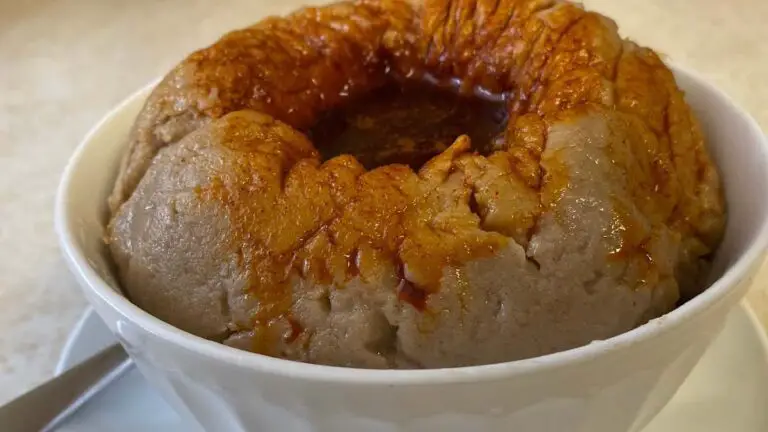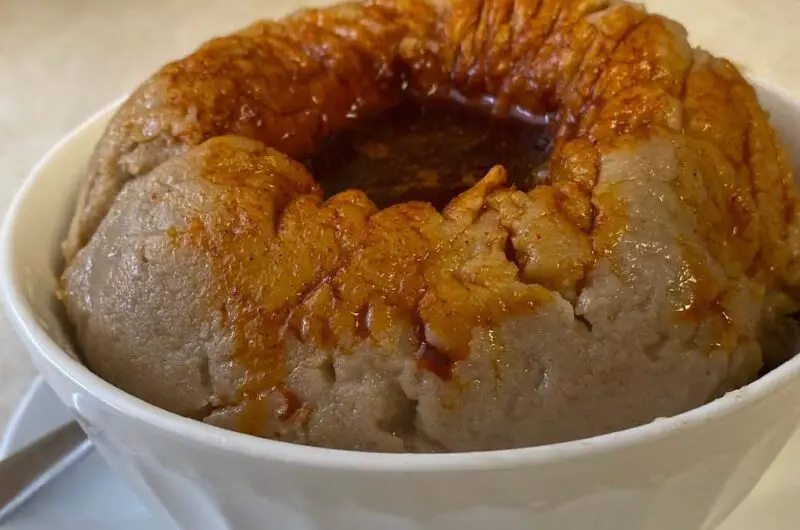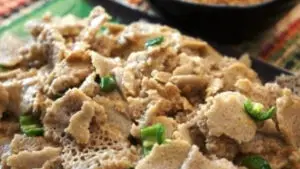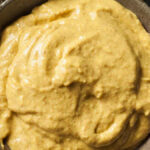Genfo is a thick, doughy porridge made from either wheat, barley, or maize flour and served, and enriched with berbere and niter kibbeh. The word ‘Genfo’ means porridge in Amharic, and is also known as Ga’at in some parts of Ethiopia and Eritrea.
Genfo is one of Ethiopia’s most iconic dishes and has been enjoyed for centuries by people of all ages throughout Ethiopia. One of the most unique features of Genfo is how it looks. When served, Genfo has a deep hole carved right in the middle where a dipping sauce made from a mixture of berbere and niter kibbeh is poured in.
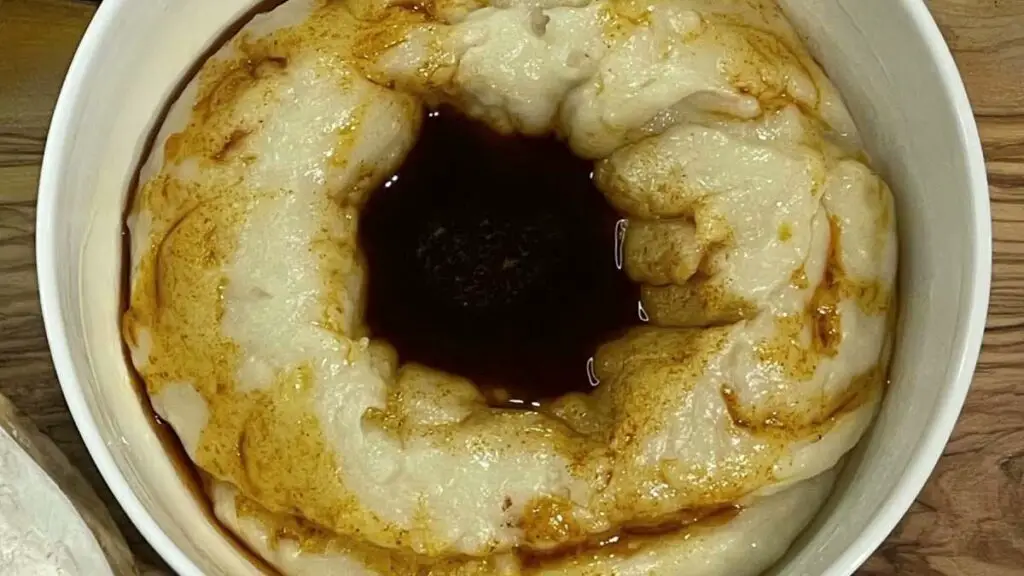
In Ethiopia, Genfo is customarily given to pregnant women and recovering new mothers as it is easily digestible, easy to make, as well as a nutrient-rich food source that helps them heal and regain strength quickly.
Genfo can be shared or consumed individually, either by hand or using a spoon.
Why You’ll Love Genfo
Genfo is quite a popular breakfast dish, especially in Ethiopia and Eritrea. Here’s why:
- Flavorful and unique: While the porridge itself is relatively plain, the combination of the porridge with the rich and spicy niter kibbeh in the dipping sauce creates a delicious contrast in taste and texture. Moreover, the fiery berbere in the dipping sauce adds a unique kick that some people find very enjoyable.
- Comforting and filling: The thick and doughy texture of Genfo is satisfying and provides sustained energy due to the carbohydrates in the flour. It’s a warm and comforting breakfast option, especially on those chilly mornings.
- Healthy and nutritious: Traditionally made with barley flour, Genfo is a good source of fiber and other nutrients. It can be a part of a balanced and healthy diet.
- Cultural significance: Genfo is a staple food in Ethiopia and Eritrea, and enjoying it allows you to connect with the culinary traditions of these regions. It’s also traditionally offered to new mothers as a recovery food, highlighting its role in Ethiopian culture.
All in all, if you enjoy savory and flavorful breakfasts, and you’re adventurous and open to trying new things, Genfo is definitely worth a try!
What You’ll Need to Make Genfo
- wheat flour
- niter kibbeh (Ethiopian clarified butter)
- berbere
- cardamom
- water
Equipment Recommendations
Affiliate Disclaimer: As an affiliate, we get commissions for purchases made through links on this website from Amazon and other third parties.
How to Make Genfo (Step-by-Step Tutorial)
- Start by adding the cardamom to the flour and mix.
- Boil the water then start adding the flour mix slowly while reducing the heat, stirring thoroghly so as to avoid any lumps from forming and until the mix moistenes well enough.
- Then transfer the Genfo to a mid-sized bowl, and create a hole right in the middle.
- Melt the Niter Kibbeh, and mix with the berbere, then pour the mix into the hole you created in the middle of the Genfo.
- Finally, pour the spicy liquid into the hole you’ve hollowed out in the Genfo and serve while still hot.
Variations
In Ethiopia, Genfo is typically made using barley flour, it can also be made using wheat and maize. It is also common in Eritrea to find Genfo (Ga’at) made using coarse-ground cornmeal, most likely from the Italian influence.
In parts of Ethiopia, you can find Bula Genfo, which is made from the powdered roots of the Enset tree, also known as the false banana tree.
In terms of consistency, the thickness of the porridge can be controlled by adjusting the water content. More water for a thinner consistency, and less for a thicker one.
While Genfo is typically not a sweet dish, you can add some honey for a sweeter breakfast porridge.
Moreover, while not used in Genfo itself, milk and yogurt can be interesting accompaniments depending on your preference.
Storage Guide
Genfo can be stored, but it’s important to manage your expectations because the texture and quality will degrade over time. Here’s what to consider:
- Fresh is best: Genfo is best enjoyed fresh as it has the desired thick and doughy texture. The longer it sits, the more it can dry out or become slightly mushy.
- Storage methods: If you do have leftover Genfo , you can store it in an airtight container in the refrigerator for 1-2 days.
- Reheating: When reheating, you might need to add a little bit of water or broth to bring back some moisture and achieve the right consistency. Microwaving is not ideal as it can cause uneven heating and drying.
Overall, while Genfo can be stored for a short time, freshness is key for the best texture and taste.
Other Ethiopian Breakfasts You Must Try
- Dulet (Ethiopian Fried Tripe and Liver) Recipe
- Kinche (Sautéed Cracked Wheat) Recipe
- Firfir Recipe (Authentic & Vegan Friendly)
- Enkulal Firfir (Ethiopian Scrambled Eggs) Recipe
- Chechebsa (Kita Firfir) Recipe
- Ful (Ethiopian Spicy Fava Beans) Recipe
